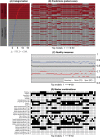Predicting disease progression in behavioral variant frontotemporal dementia
- PMID: 35005196
- PMCID: PMC8719425
- DOI: 10.1002/dad2.12262
Predicting disease progression in behavioral variant frontotemporal dementia
Abstract
Introduction: The behavioral variant of frontotemporal dementia (bvFTD) is a rare neurodegenerative disease. Reliable predictors of disease progression have not been sufficiently identified. We investigated multivariate magnetic resonance imaging (MRI) biomarker profiles for their predictive value of individual decline.
Methods: One hundred five bvFTD patients were recruited from the German frontotemporal lobar degeneration (FTLD) consortium study. After defining two groups ("fast progressors" vs. "slow progressors"), we investigated the predictive value of MR brain volumes for disease progression rates performing exhaustive screenings with multivariate classification models.
Results: We identified areas that predict disease progression rate within 1 year. Prediction measures revealed an overall accuracy of 80% across our 50 top classification models. Especially the pallidum, middle temporal gyrus, inferior frontal gyrus, cingulate gyrus, middle orbitofrontal gyrus, and insula occurred in these models.
Discussion: Based on the revealed marker combinations an individual prognosis seems to be feasible. This might be used in clinical studies on an individualized progression model.
Keywords: behavioral variant frontotemporal dementia; brain volume; classification models; disease progression; frontotemporal dementia; prognosis.
© 2021 The Authors. Alzheimer's & Dementia: Diagnosis, Assessment & Disease Monitoring published by Wiley Periodicals, LLC on behalf of Alzheimer's Association.
Conflict of interest statement
The authors declare no conflicts of interest.
Figures



References
-
- Devenney E, Bartley L, Hoon C, et al. Progression in behavioral variant frontotemporal dementia: a longitudinal study. JAMA Neurol. 2015; 72(12): 1501‐1509. - PubMed
-
- Zhutovsky P, Vijverberg EGB, Bruin WB, et al. Individual prediction of behavioral variant frontotemporal dementia development using multivariate pattern analysis of magnetic resonance imaging data. J Alzheimers Dis. 2019; 68(3): 1229‐1241. - PubMed
LinkOut - more resources
Full Text Sources
